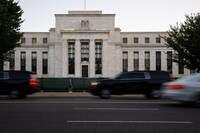The financial system isn’t at risk of a 2008-style meltdown, but fresh threats are complicating the Federal Reserve’s aggressive campaign to tame some of the highest inflation in 40 years, the central bank warned Friday.
Global financial system under pressure from all sides, Fed report says

The Fed’s tightening campaign — which includes its fourth consecutive 0.75 percentage point increase issued Wednesday — coincides with moves by other major central banks to hike rates. Together, these could further strain the global financial system.
Tremors in the market for U.S. Treasury bonds have also drawn the attention of investors and some Washington policymakers. Those bonds are a key pillar of the global financial system. But there are early signs that the pool of interested buyers could run dry as one unintended consequence of rising rates.
“Today’s environment of rapid synchronous global monetary policy tightening, elevated inflation, and high uncertainty associated with the pandemic and the war raises the risk that a shock could lead to the amplification of vulnerabilities, for instance due to strained liquidity in core financial markets or hidden leverage,” Fed Vice Chair Lael Brainard said in a statement accompanying the report.
The report, which comes out each May and November, did not send immediate alarms. Instead, it sought to map out a range of potential threats that could hit the financial system, including unforeseen shocks or any unintended consequences from the Fed’s fight against inflation. In the United States, for example, analysts took heed from the extreme market turmoil in Britain that accelerated the political demise of former prime minister Liz Truss and prompted added scrutiny of bond mutual funds, pensions, corporate debt and government finances.
Still, the Fed wrote, the banking system appears stable and household debt has not emerged as a major source for concern. Prices of risky assets have fallen as the economic outlook has deteriorated and interest rates have risen.
The last five months have brought plenty of bumps in the United States and abroad, and the chief concern remains getting inflation under control. But in contrast to the years leading up to the Great Recession, when the housing market led to a massive meltdown of the financial system, policymakers are not worried about the same kind of instability now.
After home prices exploded over the past few years, the Fed is aiming to slow the market through higher interest rates that, in turn, lead to costlier mortgages and eventually lower home prices. Although the drop hasn’t yet reached the rental market, realtors and housing experts aren’t bracing for a market crash.
Still, vulnerabilities remain. Among the groups surveyed by the Fed, no respondents in May cited market liquidity strains and volatility as a concern. But by November, 54 percent of contacts cited the risk. Attention also grew around a possible conflict between China and Taiwan — up from 14 percent to 42 percent.
Slightly fewer respondents said they were concerned about inflation staying high while rates go up — 68 percent in the May report, compared to 62 percent now. Russia’s invasion of Ukraine also prompted slightly fewer concerns — 77 percent versus 62 percent.
But the economic consequences of the war in Ukraine, and geopolitical tensions elsewhere, continue to ripple. Europe is staring down a severe energy crisis this winter, following Russian President Vladimir Putin’s decision to halt natural gas deliveries via the Nord Stream 1 pipeline and Europe’s tightening embargoes on Russian energy. The U.S.-China relationship is also under economic and national security pressures.
Meanwhile, the Fed’s steep rate increases have strengthened the U.S. dollar. But that, in turn, weakens other currencies and makes other countries’ fight against inflation even more difficult.






